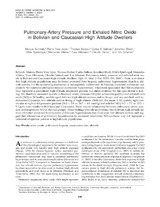Pulmonary-artery pressure and exhaled nitric oxide in Bolivian and caucasian high altitude dwellers

View/
Date
2008Author
Schwab, Marcos
Jayet, Pierre-Yves
Stuber, Thomas
Salinas Salmón, Carlos E
Bloch, Jonathan
Spielvogel, Hilde
Villena, Mercedes
Allemann, Yves
Sartori, Claudio
Scherrer, Urs
Metadata
Show full item recordAbstract
Abstract.
There is evidence
that high altitude populations may be better protected from hypoxic pulmonary hypertension than low altitude natives, but the underlying mechanism is incompletely understood. In Tibetans, increased pulmonary respiratory NO synthesis attenuates hypoxic pulmonary hypertension. It has been speculated that this mechanism
may represent a generalized high altitude adaptation pattern, but direct evidence for this speculation is lackoxide (NO) in 34 healthy, middle-aged Bolivian high altitude natives and in 34 age- and sex-matched, well-acclimatized Caucasian low altitude natives living at high altitude (3600 m). The mean ! SD systolic right ventricular to right atrial pressure gradient (24.3 ! 5.9 vs. 24.7 ! 4.9 mmHg) and exhaled NO (19.2 ! 7.2 vs. 22.5 !
9.5 ppb) were similar in Bolivians and Caucasians. There was no relationship between pulmonary-artery pressure and respiratory NO in the two groups. These findings provide no evidence that Bolivian high altitude natives are better protected from hypoxic pulmonary hypertension than Caucasian low altitude natives and suggest that attenuation of pulmonary hypertension by increased respiratory NO synthesis may not represent a
universal adaptation pattern in highaltitude populations.
